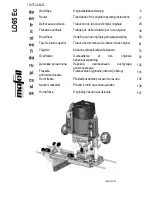
The information contained in this document is subject to change. This document contains proprietary information, which is protected by copyright
laws. All rights are reserved. No part of this document may be photocopied, reproduced or translated to another language or program language
without prior written consent of RFI Engineering B.V.
RefGuide_U-routerNGW_v1.01.docx
Page: 23(
57)
Each relay can be given a meaningful description. For example, which device it operates. The
description is stored on the RPSW itself.
11.3 LED indicators on the RPSW
During normal operation the blue LED on the RPSW flashes every two seconds. This indicates that
the software in the RPSW is running normally. When the relay is OFF, the green LED is off. When
the relay is in the ON position the green LED will be on.
11.4 Last relay position is saved in the EEPROM
The last relay position is always saved to the EEPROM of the RPSW and periodically broadcast over
the RS485 network. This is done to ensure that the relay will not accidentally be triggered when
other components of the RS485 network are unplugged or rebooted. For example; if you reboot the
U-router NGW you don’t want your RPSW to momentarily be switched off during reboot, thereby
causing a service disruption. Also, in case of power loss, the RPSW relay will return in the original
position when power is restored. So, when the RPSW was switched off before the power loss, it will
be restarted in the off position when the power is restored.
When an RS485 RPSW leaves the factory the default communication mode is set to RIOT. This choice
was prompted by the need to have a zero-configuration deployment and the need to have multiple
hosts on the RS485 bus that communicate with each other. These two requirements make the
Modbus RTU protocol unsuitable for our purpose because Modbus must have a master device
configuration and can only address slaves numbered 1 to 255. In which case each slave needs to be
pre-configured with a slave address prior to deployment.
Using the RIOT protocol, you can address more than 16 million devices. Each RIOT capable device
has a unique Device ID, similar to a MAC address. In fact the Device ID numbering comes out of the
OUI range allocated to RFI Engineering BV (40:28:14:00:00:00 - 40:28:14:FF:FF:FF). Both the
serial number as well as the device address are printed on the bottom of the unit.
















































